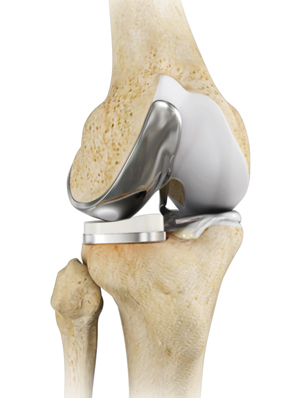Dr. Makda provided EXCEPTIONAL care to my father for his knee replacements.
Dr. Makda provided EXCEPTIONAL care to my father for his knee replacements. His attention to his patients and willingness to explain the treatment pla...

Arthritis is inflammation of a joint causing pain, swelling (inflammation), and stiffness.
Osteoarthritis is the most common form of knee arthritis in which the joint cartilage gradually wears away. It most often affects older people. In a normal joint, articular cartilage allows for smooth movement within the joint, where as in an arthritic knee the cartilage itself becomes thinner or completely absent. In addition, the bones become thicker around the edges of the joint and may form bony “spurs”. These factors can cause pain and restricted range of motion in the joint.
The exact cause is unknown, however, there are several factors that are commonly associated with the onset of arthritis and may include:
Arthritis of the knees can cause knee pain, which may increase after activities such as walking, stair climbing or kneeling.
The joint may become stiff and swollen, limiting the range of motion. Knee deformities such as knock-knees and bow-legs may also occur.
Your doctor will diagnose osteoarthritis based on the medical history, physical examination, and X-rays.
X-rays typically show a narrowing of joint space in the arthritic knee.
Unicompartmental knee replacement is a minimally invasive surgery in which only the damaged compartment of the knee is replaced with an implant. It is also called a partial knee replacement.
The knee can be divided into three compartments: patellofemoral, the compartment in front of the knee between the kneecap and thighbone, medial compartment, on the inside portion of the knee, and lateral compartment which is the area on the outside portion of the knee joint.
Traditionally, total knee replacement was commonly indicated for severe osteoarthritis of the knee. In total knee replacement, all worn out or damaged surfaces of the knee joint are removed and replaced with new artificial parts. Partial knee replacement is a surgical option if your arthritis is confined to a single compartment of your knee.
Your doctor may recommend surgery if non-surgical treatment options such as medications, injections and physical therapy have failed to relieve the symptoms.
During the surgery, a small incision is made over the knee to expose the knee joint. Your surgeon will remove only the damaged part of the meniscus and place the implant into the bone by slightly shaping the shinbone and the thighbone. The plastic component is placed into the new prepared area and is secured with bone cement. Now the damaged part of the femur or thighbone is removed to accommodate the new metal component which is fixed in place using bone cement. Once the femoral and tibial components are fixed in proper place the knee is taken through a range of movements. The muscles and tendons are then repaired and the incision is closed.
You may walk with the help of a walker or cane for the first 1-2 weeks after surgery. A physical therapist will advise you on an exercise program to follow for 4 to 6 months to help maintain range of motion and restore your strength. You may perform exercises such as walking, swimming and biking but high impact activities such as jogging should be avoided.
Possible risks and complications associated with unicompartmental knee replacement include:
The advantages of Unicompartmental Knee Replacement over Total Knee Replacement include:
Dr. Makda provided EXCEPTIONAL care to my father for his knee replacements.
Dr. Makda provided EXCEPTIONAL care to my father for his knee replacements. His attention to his patients and willingness to explain the treatment pla...
I had needed knee replacements for quite awhile.
I had needed knee replacements for quite awhile. I even saw other doctors about it but never moved forward as I realized now it all was never explaine...
Dr. Makda is wonderful. He is kind, very knowledgeable and offers different types of recovery for knee problems. After 3 visits I was released from ca...
My left knee was replaced in the hands of Dr Makda last July
My left knee was replaced in the hands of Dr Makda last July. Now my right hip in 2 weeks (mid April 2019).
All went as expected. Have to do all the therapy if you want to recover fast.
All went as expected. Have to do all the therapy if you want to recover fast. Very happy with my new left knee.
100 Village Green Drive
Suite 120
Lincolnshire, IL 60069